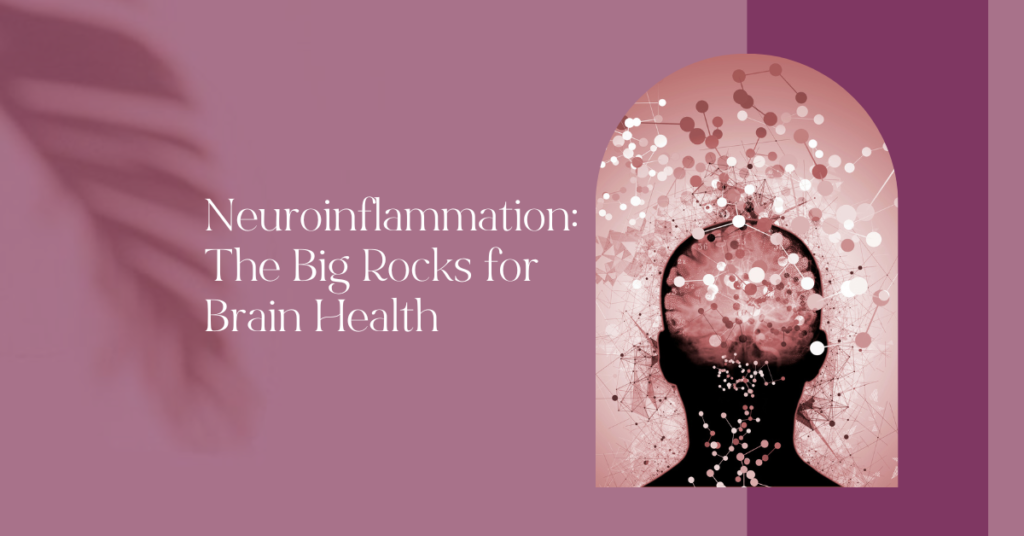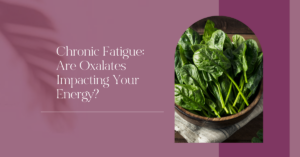Neuroinflammation refers to inflammation that occurs in the brain or nervous system, either as a protective response to injury or infection or as a result of chronic neurological conditions.
Neuroinflammation involves the activation of the immune system in the brain, including immune cells such as microglia and astrocytes, as well as the release of various inflammatory molecules such as cytokines, chemokines, and reactive oxygen species (ROS).
The chronic activation of the immune system in the brain can lead to progressive damage and dysfunction of neurons and other brain cells, contributing to the development and progression of dis-ease over time.
Research into the mechanisms of neuroinflammation is ongoing, and there is growing interest in developing treatments that target the immune response in the brain to improve outcomes for individuals with neurological disorders and neurological symptoms.
Neuroinflammation and Energy
Neuroinflammation can have a profound effect on energy levels by disrupting mitochondrial function, altering neurotransmitter levels, and influencing metabolic dysfunction and impairing the functioning of the HPA axis.
Neurotransmitters
It has been suggested that neuroinflammation can affect energy levels by altering the functioning of brain cells and disrupting the balance of neurotransmitters that regulate energy metabolism.
Mitochondria and ATP
One way in which neuroinflammation can affect energy is by impairing the function of mitochondria. Mitochondria are the cellular organelles responsible for generating energy in the form of ATP.
Mitochondrial dysfunction has been linked to a wide range of neurological disorders, including Alzheimer’s disease, Parkinson’s disease, and multiple sclerosis, which are all characterised by chronic neuroinflammation.
Hypothalamic-Pituitary-Adrenal (HPA) axis
Neuroinflammation can disrupt the functioning of the hypothalamic-pituitary-adrenal (HPA) axis, which is the body’s primary stress response system.
The HPA axis regulates the release of cortisol, a hormone that helps to mobilise energy reserves in response to stress. Chronic neuroinflammation can lead to dysregulation of the HPA axis, resulting in decreased cortisol levels and impaired energy mobilisation.
In addition to being a stress hormone, cortisol is an anti-inflammatory hormone. Which means that decreased cortisol levels perpetuate the cycle of inflammation.
Metabolic Dysfunction
The relationship between neuroinflammation and metabolic dysfunction is complex and bidirectional, with each contributing to and exacerbating the other.
Neuroinflammation disrupts the functioning of the hypothalamus, a region of the brain that plays a key role in regulating energy balance and glucose metabolism. In response to inflammation, the hypothalamus can become insulin resistant, which impairs its ability to sense and respond to changes in energy and glucose levels in the body. This can lead to dysregulated appetite and energy expenditure and the development of obesity and type 2 diabetes over time.
Additionally, neuroinflammation can also affect peripheral tissues such as adipose tissue, liver, and skeletal muscle. Pro-inflammatory cytokines impact these tissues which can impair insulin signalling and promote insulin resistance.
Conversely, metabolic dysfunction can contribute to the development of neuroinflammation by promoting oxidative stress. Oxidative stress can activate the immune cells in the brain that are responsible for mediating neuroinflammation. Furthermore, metabolic dysfunction can also lead to the accumulation of metabolic byproducts, such as advanced glycation end products (AGEs), which can promote neuroinflammation and impair brain function.
When neurons are damaged, surrounding brain cells may work extra hard to compensate and therefore, neuroinflammation can, in some cases, be a cause of hypoglycemia, as the brain burns quickly through the body’s energy stores in order to function. Hypoglycemia then exacerbates brain function because there is insufficient energy for health brain cells to work appropriately.
Supporting Neuroinflammation
Neuroinflammation is the result of chronic activation of the immune system in the brain that can lead to progressive damage and dysfunction of neurons and other brain cells. Therefore, neuroinflammation, when left unsupported over time, may lead to dis-ease and symptom progression.
When supporting neuroinflammation we must consider two important things:
- What is the root cause of the neuroinflammation and how do we address it? Examples:
- Trauma: physical such as Traumatic Brain Injury (TBI) or Concussion or emotional trauma
- Infections
- Immune dysregulation and autoimmune disorders
- What does the brain need to be healthy in general? Examples:
- Glucose
- Oxygen and Blood Flow
- Sleep
- Appropriate stimulation (not too much or too little)
- Anti-inflammatory support
- The absence of pro-inflammatory triggers such as:
- Foods: including, but not limited to, gluten, dairy, processed carbohydrates and seed oils
- Infections
- Autoimmunity
- Toxins
Root Causes of Neuroinflammation
Identifying the factors that are keeping the brain in an inflamed state will be important when it comes to addressing neuroinflammation. Here are some factors to consider.
Toxins
There are many toxins that can cause neuroinflammation, and the specific toxins involved will depend on the individual and their environment. Here are some examples:
- Heavy metals: exposure to heavy metals such as lead, mercury, and cadmium can lead to neuroinflammation. Heavy metals can be tested with blood or urine.
- Pesticides: exposure to pesticides, particularly organophosphates, has been linked to neuroinflammation.
- Air pollution: exposure to air pollution, particularly fine particulate matter, has been linked to neuroinflammation.
- Alcohol: chronic alcohol use can lead to neuroinflammation.
- Certain drugs: some prescription drugs, such as chemotherapeutic agents and antipsychotics, have been associated with neuroinflammation.
- Mycotoxins: One of the most well-known mycotoxins associated with neuroinflammation is ochratoxin A. Mycotoxins can be tested with the Mosaic Mycotoxin Testing Panel.
It’s important to note that this is not an exhaustive list and that other toxins can also cause neuroinflammation. Additionally, some of these toxins may not cause neuroinflammation in every individual and may depend on factors such as dose and duration of exposure, as well as individual susceptibility.
Infections
Some of the most common infections that can lead to neuroinflammation include:
- Bacterial infections
- Viral infections
- Fungal infections
- Parasitic infections
- Lyme disease and Lyme Co-infections which include viral and parasitic infections can all cause neuroinflammation. Tests for Lyme and coinfections can be done using a blood panel for IgG and IgM antibodies, such as this one by Immunosciences.
Identifying infections is not always easy. It is usually best done by taking a proper case history, evaluating symptoms, using tests to support decision making and monitoring responses to interventions.
It’s important to note that the severity and symptoms of neuroinflammation can vary depending on the type of infection and the individual’s immune response. Some people may have only mild symptoms, while others may experience more severe and long-lasting effects. Identifying and addressing infections sooner rather than later can prevent or minimise neuroinflammation and its potential complications.
Trauma and Neuroinflammation
In the category of trauma and neuroinflammation we have two subcategories:
- Physical trauma that arises from physical impact with the head (e.g. car accident, concussion from playing sports etc.)
- Emotional trauma
Emotional Trauma
Emotional trauma can trigger a range of different physiological function that may impact brain health and neuroinflammation. These include:
- Changes in the stress response e.g. cortisol levels which are too high or low
- Altered immune response which may make the body more susceptible to infection or the development of an autoimmune condition
- Alterations in brain structure and function: These changes can include alterations in the size and activity of the amygdala and hippocampus, which are regions of the brain involved in emotional regulation and memory processing. These changes can lead to increased susceptibility to inflammation in the brain and nervous system.
Physical Trauma and Neuroinflammation
Physical trauma can cause neuroinflammation through the release of pro-inflammatory molecules, such as cytokines and chemokines, by cells in the injured area. These molecules attract immune cells, such as microglia and macrophages, to the site of injury, which then release additional pro-inflammatory molecules and can cause further damage to the neurons.
In addition, physical trauma can also cause damage to the blood-brain barrier (BBB), which normally prevents immune cells and other molecules from entering the CNS. When the BBB is damaged, immune cells and other molecules can enter the CNS and contribute to neuroinflammation.
Furthermore, physical trauma can also lead to the activation of the complement system, which is a part of the immune system that can promote inflammation and damage to cells. The activation of the complement system can contribute to the development of neuroinflammation following physical trauma.
Overall, physical trauma can cause neuroinflammation through a complex interplay of pro-inflammatory molecules, immune cells, and the complement system. Understanding these mechanisms can help to develop a support plan to reduce neuroinflammation and promote healing after physical trauma.
Immune Dysregulation
Immune dysregulation refers to a situation where the immune system is either overactive or underactive, leading to an inappropriate immune response. This can cause neuroinflammation through a complex interplay of immune cells, pro-inflammatory molecules, autoantibodies, and the complement system.
Immune dysregulation can cause neuroinflammation through the activation of immune cells in the CNS. Microglia and astrocytes are two types of immune cells in the CNS that are normally present in a quiescent state. However, in response to immune dysregulation, these cells can become activated and release proinflammatory molecules, leading to neuroinflammation.
In addition, immune dysregulation can also lead to the production of autoantibodies, which are antibodies that target the body’s own tissues. In the CNS, autoantibodies can target neuronal proteins and cause damage to neurons.
Furthermore, immune dysregulation can also result in the activation of the complement system, which is a part of the immune system that can promote inflammation and damage to cells. The activation of the complement system can contribute to the development of neuroinflammation following immune dysregulation.
Big Rocks For Brain Health
Once you have identified the underlying triggers for neuroinflammation and you have a plan for managing them, you want to create stability by giving the brain what it needs to thrive.
Glucose
The brain primarily uses glucose, a type of sugar, as its main source of fuel. Glucose is obtained from the breakdown of carbohydrates that are consumed in the diet, such as bread, pasta, rice, fruits and vegetables.
The brain needs glucose to thrive. But that doesn’t mean more is better. If blood glucose is too high, brain glucose penetration can be poor which means that brain cells cannot get the energy they need to function. Low blood glucose increases oxidative stress which can damage neurons and ATP production.
Therefore, the goal is to maintain glucose in a narrow range. You can read more about how to do that here.
Ketones are produced from the breakdown of fat in the liver when glucose availability is low. Ketones can cross the blood-brain barrier and be used by the brain as an energy source when glucose is not readily available. Additionally, ketones may help to modulate inflammatory cytokines in the brain.
It may be necessary for some people to engage with a ketogenic diet to manage inflammation and increase brain energy. This may be a temporary solution while brain health is restored or a long term commitment. You can read more about a ketogenic diet here.
Blood Flow and Oxygen
The brain needs a healthy flow of blood, which transports oxygen to brain cells. Oxygen is used to make energy in the form of ATP in brain cells.
Things you can do to support healthy blood flow to the brain:
- Optimise blood pressure: not too low or too high, ideally 120/80
- Move your body and exercise as much as you can within your capacity
- Rest with your legs up the wall to encourage blood flow to the brain
- Stay hydrated and consume electrolytes for healthy blood volume
- Address breathing issues such as asthma or sleep apnea
- Ensure SPO2 is above 95% ideally closer to 98%
- Address poor circulation
In addition to a healthy amount of blood flowing to the brain we also need healthy red blood cells which requires adequate amounts of Vitamin B6, Vitamin B12 and Folate. You can read more here about how to Assess and Address Anaemia in the case of Chronic Fatigue.
Supplements such as Gingko Biloba and Vinpocentine can encourage blood flow to the brain.
Sleep
During sleep, the brain performs important restorative functions, such as consolidating memories, repairing damaged tissue, and flushing out toxins. Therefore, getting a good night’s sleep is essential for supporting brain health generally and neuroinflammation specifically.
There are lots of ways that we can support and optimise sleep including:
- Morning light exposure
- Blood sugar control
- Stress management
- Modulating evening night exposure
- Cortisol Modulation through diet, lifestyle and supplements
- Creating an evening sleep routine
- Addressing histamine intolerance / MCAS
- Addressing underlying infections
- Appropriate exercise
- Supplements that support sleep (like L-theanine, Lemon Balm, Glycine and Magnesium Threonate)
You can read about this in more detail here.
Managing Inflammation
Given that the challenge is neuroinflammation, we want to support the modulation of the immune system towards an anti-inflammatory signal.
This is done in several ways:
- Removing pro-inflammatory triggers: foods, toxins, trauma, microbes
- Consuming an anti-inflammatory diet, which might involve:
- Removing processed food, fried foods, sugar and processed seed oils
- Stable blood sugar
- An abundance of tolerated plants, herbs and spices (aim for 20 different types per day!)
- Balance of essential fatty acids: The general recommendation is to consume a ratio of omega-6 to omega-3 fatty acids that is around 4:1 or lower.
- Addressing and supporting digestive health: 70% of our immune system is located in and around our digestive tract and therefore optimal digestive health is important for immune modulation.
- Managing stress and supporting the Nervous System
Certain plants, known as polyphenols may be beneficial for brain health. Polyphenols have been reported to be particularly beneficial in combating oxidative stress. They are neuroprotective and have potential to suppress neuroinflammation and promote memory, learning, and cognitive function.
The most abundant sources of polyphenols, in order of abundance, are:
- black elderberry
- black chokeberry
- blackcurrant
- highbush blueberry
- globe artichoke heads
- filter coffee
- lowbush blueberry
- sweet cherry
- strawberry
- blackberry
- plum
- red raspberry
- flaxseed meal
- dark chocolate
- chestnut
- black tea
- green tea
- pure apple juice
- whole grain rye bread
- hazelnut
- red wine
- soy yoghurt
- cacao powder
- pure pomegranate juice
- soy flour
- black grape
- black olive
- pure grapefruit juice
- pure blood orange juice
- milk chocolate
- spinach
- pecan nut
- prune
- red currant
- soy tempeh
- peach
- soy tofu
- green olive
- black bean
- red onion
- green grape
- white bean
- chocolate beverage with milk
- roasted soy bean
- potato
- shallot
- soy milk
- red chicory
- broccoli
Supplements
Supplements are supplementary. Supplements can make a big difference but they are not an alternative to addressing the root cause, getting enough sleep, managing blood sugar, addressing oxygenation issues, eating a healthy diet and moving your body.
Neuroinflammation is a serious health concern and therefore, we want to have a multi-pronged approach, of which supplements are a small part.
Supplements that I like for modulating neuroinflammation may include:
- A good quality fish oil supplement where you can achieve 3g-4g of EPA+DHA per day
- Glutathione for antioxidant support
- And/or a good quality plant based antioxidant like curcumin, resveratrol or green tea
- Creatine may have neuroprotective and anti-inflammatory effects, and may therefore have potential for reducing neuroinflammation
- Butyrate and/ or Probiotics for digestive support – the gut is the second brain after all
Conclusion
Addressing and supporting neuroinflammation is complex and multifaceted BUT it is possible to recover your health, energy and brain function when you have the right support in place.
You can also listen to my podcast episode on Neuroinflammation (it’s episode 31!) where I talk about neuroinflammation from a psychoneuroimmunology perspective.










